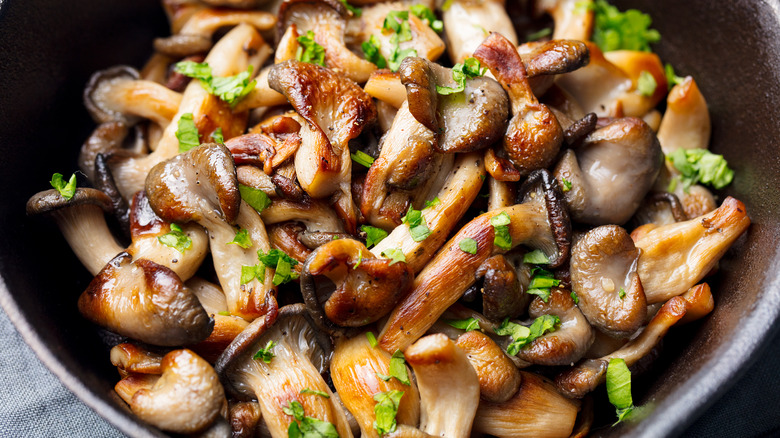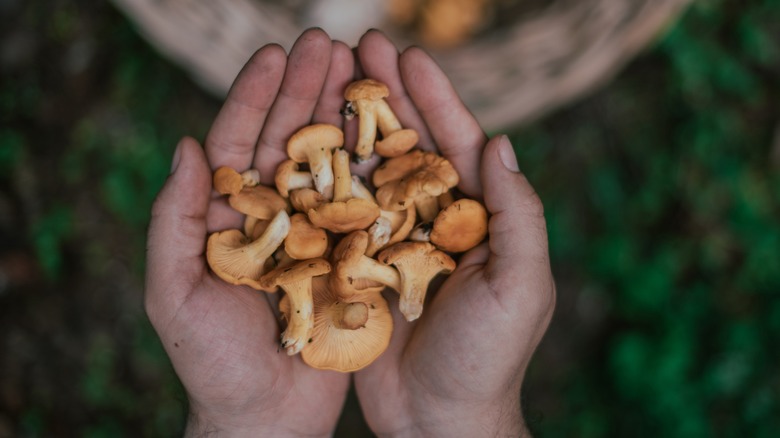How To Cook Mushrooms Without Getting Them Too Soggy
Mushrooms have quite a unique character in the world of food; there's nothing else quite like them. First of all, there are over 10,000 different types of mushrooms — that we know of — some edible, some poisonous. Considered a vegetable by dietary standards, by scientific standards, the mushroom is not a plant or an animal — it's a fungus.
Sounds appetizing, right? Somehow these dirty fungi that look unlike anything else we eat, with their gills and fleshy caps and notorious rubbery texture, are delicious. Mushrooms provide an earthy, savory, umami-like flavor that can add depth and dimension to any dish, from steak to omelets and pasta. They're also meaty and flavorful enough to be enjoyed independently, whether grilled, roasted, or sauteed.
The key to enjoying mushrooms is to cook them correctly because their texture can certainly be off-putting, and no one likes a soggy mushroom. But a mushroom done right can do wonders. Let's talk about the best ways to cook them so you can make the most of these strange, tasty little shrooms.
Perfectly cooked mushrooms, two ways
Mushrooms are naturally high in moisture (they're typically 80-90% water), which means they risk becoming soggy when cooked. The trick to making sure your mushrooms taste as delicious as they should is to cook them in a way that brings out their best qualities and flavors. To get the best results, you want them to caramelize and crisp up rather than steam and soften into a mushy texture.
There are two main ways you can do this. The first is roasting, which will produce golden brown mushrooms and crispy on the outside yet still tender on the inside. The key to ensuring they're tender but not soggy is to crank up the heat. Roast your mushrooms at a high temperature of 450 F for around 20 minutes, preventing them from steaming in their own liquid.
The second method is to sauté your mushrooms, which will achieve that delicious caramelization. But remember that mushrooms have a lot of liquid to release once they start cooking, so rather than sauté them in oil or butter immediately, a good tip is to let them cook and crisp in the pan on their own first over medium-high heat. Dry sautéing will brown the mushrooms and enhance their flavors, while allowing their moisture to escape so they don't become mushy.
The benefits of eating mushrooms
We don't just eat mushrooms because they taste good; these unassuming fungi are extremely good for you too. Not only are they a low-calorie, low-sodium food with no fat or cholesterol, but they come with a slew of antioxidants, vitamins, and macronutrients that benefit the entire body.
One of the most significant benefits of eating mushrooms is their role in preventing disease. A review of 17 cancer studies over 54 years found that eating just ⅛ cup of mushrooms daily can lower your risk of cancer by up to 45% thanks to ergothioneine, a cellular-damage-fighting amino acid found in the fungi. Mushrooms also help reduce our body's cholesterol levels, protecting against heart disease.
Plus, mushrooms are packed with beneficial vitamins, minerals, and nutrients like Vitamin D, Vitamin B6, and Selenium — supporting a healthy immune system, reducing inflammation, and promoting the growth of healthy bacteria in the gut. So keep enjoying your mushrooms regularly, and try these tricks to get a different texture than the mush-like pile you may be used to.


